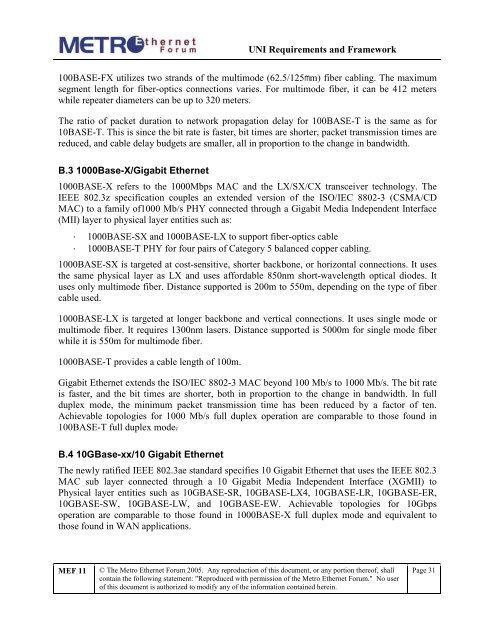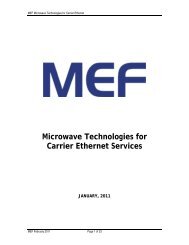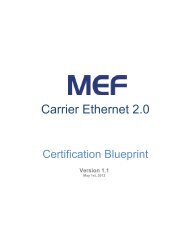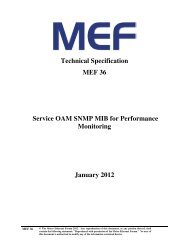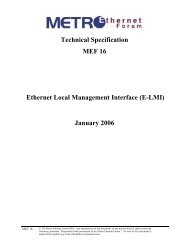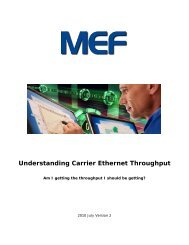User Network Interface (UNI) Requirements and Framework - MEF
User Network Interface (UNI) Requirements and Framework - MEF
User Network Interface (UNI) Requirements and Framework - MEF
You also want an ePaper? Increase the reach of your titles
YUMPU automatically turns print PDFs into web optimized ePapers that Google loves.
<strong>UNI</strong> <strong>Requirements</strong> <strong>and</strong> <strong>Framework</strong><br />
100BASE-FX utilizes two str<strong>and</strong>s of the multimode (62.5/125mm) fiber cabling. The maximum<br />
segment length for fiber-optics connections varies. For multimode fiber, it can be 412 meters<br />
while repeater diameters can be up to 320 meters.<br />
The ratio of packet duration to network propagation delay for 100BASE-T is the same as for<br />
10BASE-T. This is since the bit rate is faster, bit times are shorter, packet transmission times are<br />
reduced, <strong>and</strong> cable delay budgets are smaller, all in proportion to the change in b<strong>and</strong>width.<br />
B.3 1000Base-X/Gigabit Ethernet<br />
1000BASE-X refers to the 1000Mbps MAC <strong>and</strong> the LX/SX/CX transceiver technology. The<br />
IEEE 802.3z specification couples an extended version of the ISO/IEC 8802-3 (CSMA/CD<br />
MAC) to a family of1000 Mb/s PHY connected through a Gigabit Media Independent <strong>Interface</strong><br />
(MII) layer to physical layer entities such as:<br />
• 1000BASE-SX <strong>and</strong> 1000BASE-LX to support fiber-optics cable<br />
• 1000BASE-T PHY for four pairs of Category 5 balanced copper cabling.<br />
1000BASE-SX is targeted at cost-sensitive, shorter backbone, or horizontal connections. It uses<br />
the same physical layer as LX <strong>and</strong> uses affordable 850nm short-wavelength optical diodes. It<br />
uses only multimode fiber. Distance supported is 200m to 550m, depending on the type of fiber<br />
cable used.<br />
1000BASE-LX is targeted at longer backbone <strong>and</strong> vertical connections. It uses single mode or<br />
multimode fiber. It requires 1300nm lasers. Distance supported is 5000m for single mode fiber<br />
while it is 550m for multimode fiber.<br />
1000BASE-T provides a cable length of 100m.<br />
Gigabit Ethernet extends the ISO/IEC 8802-3 MAC beyond 100 Mb/s to 1000 Mb/s. The bit rate<br />
is faster, <strong>and</strong> the bit times are shorter, both in proportion to the change in b<strong>and</strong>width. In full<br />
duplex mode, the minimum packet transmission time has been reduced by a factor of ten.<br />
Achievable topologies for 1000 Mb/s full duplex operation are comparable to those found in<br />
100BASE-T full duplex mode.<br />
B.4 10GBase-xx/10 Gigabit Ethernet<br />
The newly ratified IEEE 802.3ae st<strong>and</strong>ard specifies 10 Gigabit Ethernet that uses the IEEE 802.3<br />
MAC sub layer connected through a 10 Gigabit Media Independent <strong>Interface</strong> (XGMII) to<br />
Physical layer entities such as 10GBASE-SR, 10GBASE-LX4, 10GBASE-LR, 10GBASE-ER,<br />
10GBASE-SW, 10GBASE-LW, <strong>and</strong> 10GBASE-EW. Achievable topologies for 10Gbps<br />
operation are comparable to those found in 1000BASE-X full duplex mode <strong>and</strong> equivalent to<br />
those found in WAN applications.<br />
<strong>MEF</strong> 11<br />
© The Metro Ethernet Forum 2005. Any reproduction of this document, or any portion thereof, shall<br />
contain the following statement: "Reproduced with permission of the Metro Ethernet Forum." No user<br />
of this document is authorized to modify any of the information contained herein.<br />
Page 31


